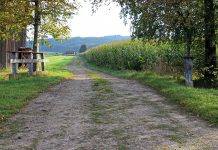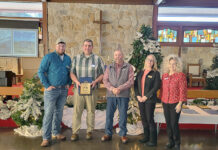Another new year has arrived with the usual mix of interesting weather for livestock producers. As we begin our attempt to keep those New Year’s resolutions, we are constantly faced with challenges and temptations.
I would like to suggest at least one resolution that you attempt to keep this year. That resolution is keeping better written records of your farm management activities.
As a minimum, get a good pocket calendar or notebook or maybe a calendar in the house or barn that you make a few notes on each day.
Basis
Record keeping is the basis for recording what you have done so that you can evaluate what worked and maybe what could be improved. It is also essential for future participation in cost share programs and incentive programs such as the Conservation Stewardship Program.
But government programs aside, it will help you make better decisions about your future management based on the results of the past.
Document such things as type and quality of hay being fed, amount and type of supplement, forage height and amount when animals are turned into a field and when they are moved out.
Note the type of minerals being supplied and amount being consumed, calving or lambing rates and dates and any particular problems noticed throughout the year.
Are your soil and manure tests current and are you planning your fertility program accordingly? Are you giving proper credit for the nutrients in the manure that you are spreading?
Have you noticed particular weed problems in certain fields or areas of a field and considered what might need to be changed to correct that problem?
Have you identified a need for additional water developments of pasture divisions that might be eligible for cost share assistance through the Environmental Quality Incentive Program?
How about the need for a manure storage structure or heavy use feeding pad as the frozen ground turns back to mud when the temperatures start to warm up again.
Programs
If these programs are of interest to you, contact your local Natural Resources Conservation Service office soon to discuss the development of a Grazing Plan or Comprehensive Nutrient Management Plan.
The Natural Resources Conservation Service office may be able to assist you or help you locate a Technical Service Provider to help you develop these plans to move you closer to the front of the line for cost share assistance on the conservation practices that you have identified as being needed on your operation.
The tentative program sign up deadline for most, if not all, of the conservation cost share programs in 2010 is mid-February, but check with your local office to confirm the actual deadlines.
Good records
Again, I will stress the importance of good records as you contemplate program participation or even changes to your system.
If you remember the old adage “No job is finished until the paperwork is done” and take a couple of minutes each evening to record the daily activities, then your records will be much easier to assemble than waiting until tax time or program sign up time and trying to create a year’s worth of records in a couple of days.
You will also gain valuable insight into your operation that you might otherwise overlook. The colored leaves of autumn are replaced by frost- covered windshields and the occasional dusting of snow, our pasture management needs also shift gears.
We need to evaluate the quantity and quality of standing forage and feed options as well as the soil conditions that will affect our ability to efficiently harvest what is available.
We need to review what types and how much feed we have stored, and what supplements may need to be added to keep our livestock productive and profitable throughout the winter.
Stored feed
Let’s start with your stored feed. How many bales of hay do you have? What size are they? What is the quality? Assessing the quality may be the toughest question if you have not already pulled a forage sample and had it analyzed.
As you know, many things affect the quality of hay. We are just guessing at the relative feed value if lab test has not been completed.
Trying to remember how mature the hay was when it was cut, how much rain fell while it was drying, how dry it was when baled, how many days it laid in the field before being hauled to storage, etc. make evaluating hay quality a real challenge.
Next, let us consider how much stored grain or grain yet to be harvested we will have readily available for use this winter.
Again, have we considered the quality of the grain? Was it harvested wet and properly dried? Did the grain get moldy? What is the feed value of the stored grain that we will actually be feeding?
Stockpiled forage
Next, let us consider is the remaining or stockpiled forage we have available. As a rule of thumb, any time we can harvest stock-piled forage with grazing livestock, it is more cost effective and often better quality than feeding stored feed.
Keep in mind, as we move further into the winter, the quality of some of the stock-piled forages deteriorate faster than others. The softer grasses and clovers will not retain their quality as well as fescue when the temperature drops below freezing.
With this in mind, plan to graze the high quality legumes in the fall and early winter and save the fields with the higher amounts of fescue for later in the winter when the livestock eat it better anyway.
Fescue
Fescue tends to become more palatable during the cold weather months, thus creating a win-win situation. Fescue retains good quality during the cold weather when most of our other forages rapidly deteriorate and is more palatable than in the hot weather months, thus is the ideal forage for stockpiling.
Another bonus with fescue is that it will continue to grow in colder temperatures than most of our other forages. Decide now if you will be feeding hay out in the pasture fields. If you will, move some of the hay to the edge of the fields now while the ground is solid, and protect it with electric fence.
If you have a site that works, space the bales far enough apart that you can place a bale ring over the first bale and set the electric fence so that as each bale is consumed, you can flip the ring onto the next bale by moving the electric fence rather than starting the tractor and moving the hay.
In this manner, you can feed several bales of hay along a fence row without rutting up the field hauling the hay in wet weather.
Extend grazing season
If you have several sites on your farm where you can place a few bales along a fence row, you can effectively extend the grazing season by combining the use of the stockpiled forage and supplementing with hay while keeping the animals rotating through the pastures as long as the fields stay relatively dry and firm.
Typically, there is more damage caused by tractors hauling hay to the fields in the winter than there is caused by the livestock trampling the fields.
By planning several days or weeks ahead, the trips with the tractor on soft ground can be minimized. Consider setting several days worth of hay out on a frozen morning or while it is dry.
Soils
In deciding when and how to feed, consideration must also be given to the soils in each area. Soils that tend to be wet or easily compacted are poor areas to consider for winter feeding.
High and dry ridge tops are a good choice for the majority of the winter. Well drained, south facing slopes also offer good potential feeding areas as the sun acts as a natural heat source for these areas.
If you have a heavy use feeding area or feedlot, plan when you are going to use it. Start the year with the manure cleaned out so that you have maximum capacity.
Clean it out at appropriate times so that the manure is a beneficial nutrient rather than a waste product to be gotten rid of. Use the hard surface areas on days when the soils are soft and the livestock and equipment would do damage to the field.
Be flexible
However, be flexible when the weather is good, or the ground is frozen and the livestock could be out grazing. A heavy use area, like any other management tool, is a great asset in managing efficiently, but can become a problem if mismanaged.
Previous articles have discussed how to measure your stockpiled forages, so hopefully you have a good estimate on how many days of grazing you have available.
Remember that most of our grazing livestock will consume between 2 percent and 3 percent of their body weight in available forages per day.
Better position
Now that you have considered how much stored feed you have and how many days of available grazing you have left, you will be in a better position to decide how and when you are going to utilize your available resources.
You can shop wisely for any additional supplements that may be needed to meet the quality of feed needed for your various types of livestock.
Planning ahead will better prepare you for those decisions that must be made throughout the coming months. Consider where you will be with your livestock when it starts raining again and the fields get extremely muddy.
Where will you will go with the livestock when the temperatures drop below freezing for several days and the stock tanks start to freeze? Where do you want to be when it is time for calving or lambing?
More questions
A couple more questions to address are, “Who will be your back up if you must be away from the farm for a few days?” and “How will they know where the animals are supposed to be and what are the feeding requirements?”
Planning ahead and addressing the above issues will allow us to continue to be a part of the system that supplies the safest, most affordable and abundant food supply in the world.












